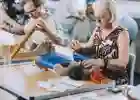Risky Cities: Living with water in an uncertain climate
Using innovative arts and humanities approaches to build climate awareness and help communities become more flood-resilient.

Project summary
The Challenge
Flood risk is rising – and not all floods can be prevented. Society needs to become more resilient and learn to live with water.
The Approach
We gathered Hull-based stories of flooding to inspire community arts activities and large-scale cultural productions exploring climate resilience.
The Outcome
Communities felt empowered by the experience, engaging with flood histories and strategies to build flood and climate awareness, action and resilience.
Institutes and centres
Lead academics

Looking back through a watery lens to a climate resilient future
We used stories of living well with water to drive engagement with positive climate futures. We inspired action for climate empowerment with over 22,470 people of all ages, helping to build flood resilience in communities across Hull.
The Challenge
Situated on the River Hull and Humber Estuary, Kingston Upon Hull (UK) is recognised globally for its vulnerability to flooding in the face of human-induced climate change. The city experienced significant flooding in 2007, 2013 and 2015, and was one of five global cities selected for participation in the Rockefeller Foundation’s and Arup’s City Water Resilience Framework development programme in 2018.
Yet international awareness of Hull’s future flood risk had previously found little reflection at the community level. Like many UK estuarine and coastal cities, public flood preparedness is low.
In 2022, only 6.6% of the population were signed up to flood alerts
Environment Agency
It is essential that our communities build resilience by becoming more aware of and adaptive to flood risks. However, prevalent climate-disaster narratives can leave people feeling disempowered - a new approach was required that would build a sense of empowerment and resilience.
The full research team
Prof Briony McDonagh
Risky Cities Lead and Professor of Environmental Humanities
Jack Chamberlain: Producer
Sarah Penney: Producer
The Approach
Working in collaboration with the Living with Water Partnership, Hull City Council and a range of creative and community organisations, Risky Cities set out to address these gaps.
We employed innovative arts and humanities approaches to spark conversations about flooding and climate change and draw on community members’ own experiences.
Our researchers gathered Hull-based stories of flooding from an 800-year history of living with water risks, including recorded floods from the 1250s onwards and several major floods since 2000.
These stories were used in community-based arts and heritage events and activities, as well as large-scale cultural productions developed in collaboration with project partners, Absolutely Cultured and the National Youth Theatre.
Community participants were encouraged to explore these histories as well as their own experiences of living with water in arts workshops involving textiles or creative writing.
Evaluation was embedded into the project at every stage, from workshop participation through to attendance at performance and exhibition events. We used a range of social science methodologies with a focus on participants recounting the impact of their involvement in their own terms. Evaluation methods included surveys, participant interviews, focus groups and reflective journals.
We used histories and stories of living with water and flood over hundreds of years of our flood-prone city, to help make big global narratives about climate change tangible and relatable at the local level – and so drive anticipatory climate action.Professor Briony McDonagh
Risky Cities lead and Professor of Environmental Humanities
Key projects
-
FloodLights: Large-scale projection and light shows in Hull City Centre, in partnership with Absolutely Cultured and Living with Water, exploring the role of water in Hull’s past and future. Artists Limbic Cinema, Vent Media, Studio McGuire, Broken Orchestra and Poet Vicky Foster, drew inspiration from the subject of “living with water”.
-
Follow the Thread: Two communities in Boothferry and Cottingham explored watery stories before working with Thread and Press and Life and Loom to make textiles-based artworks for our touring Follow the Thread exhibition. The exhibition launched at Hull’s Freedom Festival weekend, before touring to four other community venues, concluding at the University of Hull library.
-
Flow of Words: Community participants in East Hull took part in creative writing workshops, inspired by Hull histories and their own experiences of flood. The writings from these workshops were used as inspiration for five artist commissions. A vibrant mix of visual and live art performances were presented over two evenings at the University of Hull and the Freedom Centre in East Hull.
-
Wet Feet, Warm Hearts, Strong Places’ Flood Resilience Zine: Co-created with community members through a series of Zine making workshops. The Zine emphasises how we can learn from Hull’s past history and become more resilient in the present and future, providing advice on what to do in a flood and a flood plan which recipients can fill in for themselves. One of its central features involves a timeline of flood events throughout the city from the 13th century to the present day, which has been illustrated by community members.
-
On the Edge: This collaboration with the National Youth Theatre (NYT) saw researchers lead interactive workshops on climate change and its impacts These fed into the creation of NYT’s On the Edge which was performed live at COP26 and has since had over 3,700 views on youtube.
-
Risky Cities Digital Twin: Images of the Follow the Thread exhibition and recordings from the Flow of Words performances were digitised and used to create a permanent record of these creative outputs.

Risky Cities
7 mins
The Impact
The project’s innovative practices revolve around its use of what we called a ‘learning histories’ approach. We fused humanities-led research with participatory and creative elements, to drive public engagement flood, water and climate issues – and ultimately to drive water and climate action and build flood resilience.
We found that these ‘learning histories approaches offer effective tools for building flood and climate awareness action and resilience. They work at a variety of scales and are valuable for both participants and audiences. More specifically, the place-based, historically-informed and creative approaches used in Risky Cities:
- Help make complex scientific ideas meaningful and big global narratives tangible at the local level.
- Support people to understand what complex climate futures might mean for them – and what practical actions can be taken. This includes individual flood preparedness actions.
- Drive cognitive shifts and behavioural change around climate, flood risk and living with water.
- Generate genuine dialogue, knowledge exchange and co-creation, thus moving beyond deficit-based models and one-way communication about climate futures to build relational asset-based approaches.
- Offer space for difficult conversations about coastal erosion, flood risk, and loss.
These approaches offer important opportunities for co-devising action and solutions, including in collaboration with individuals and groups not previously valued in or well-engaged with government policy and action.

Find out more
Visit the Risky Cities project website for more information, blogs and publications.








